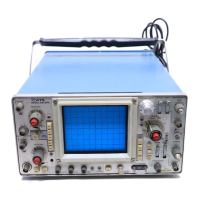TM 11-6625-2735-14-1
Input Paraphase Amplifier
Q1124 and Q1134 form the Input Paraphase Amplifier.
This is an emitter-coupled amplifier stage that converts
the single-ended input signal to a push-pull output signal.
The X10 Magnifier circuitry is in this stage and consists of
a divide-by-ten attenuator R1106-R1107-R1108. When the
X10 Magnifier is on, the input signal is applied un-
attenuated to the Input Paraphase Amplifier. When the
X10 Magnifier is off, the input signal is applied to the Input
Paraphase Amplifier through the attenuator. X10 MAG
indicator DS1110 lights when the X10 Magnifier is being
used. CR1121 and CR1122 limit signal amplitudes at the
input to the amplifier to prevent amplifier overdrive. Q1140
is a relatively constant current source for Q1124 and
Q1134. CR1140 provides temperature compensation for
the base-emitter junction of Q1140. Magnifier Registra-
tion adjustment R1130 balances quiescent DC current in
Q1124 and Q1134 so that a center screen display does not
change position when the X10 Magnifier is turned on.
Q1112 and Q1114 together form a temperature com-
pensated current source that is an interruptable path for
the horizontal positioning currents. When the TIME/DIV
switch is in any position other than X-Y, the anodes of
CR1103, CR1104, and CR1111 are connected to –8 volts
through R1104, which reverse-biases them. In the X-Y
position of the TIME/DIV switch, +5 volts is connected
directly to the anodes of CR1103, CR1104, and CR1111.
This accomplishes three things. First, the emitter-base
junction of Q1114 is reverse biased, which prevents the
Horizontal POSITION and FINE controls from having any
effect on the display. Second, relay K1103 is energized,
which connects the X-axis signal from the Channel 1
Preamplifier to the input to the Horizontal Amplifier. Third,
+5 volts is connected to the Channel 1 Scale Factor
Switching circuit so that both deflection factor indicators
are operating. When operating in the X-Y mode, R1102
adjusts for correct X-axis gain and L1103 adjusts to reduce
the phase differences between the horizontal (X) and
vertical (Y) signal paths.
Gain Setting Amplifier
Q1152 and Q1162 are an emitter-coupled push-pull
amplifier stage. The gain of this stage is adjusted to match
the CRT sensitivity. When the BEAM FINDER pushbutton
is pushed, R1168 is switched into the circuit. This reduces
the current through this stage, thereby limiting horizontal
deflection to within the limits of the CRT viewing area.
Q1152 and Q1162 operate in an overdriven mode. This
means at the extremes of signal amplitude, one side will be
turned off while the other side is still conducting. This
condition generates some common-mode signal
differences between Q1152 and Q1162. Q1164 monitors
any common-mode signal differences (through R1165
and R1167) and conducts to minimize them.
Output Amplifier
The push-pull signal from the Gain Setting Amplifier is
connected to the Output Amplifier. Each half of the Output
Amplifier can be considered as a single-ended feedback
amplifier, which amplifies the signal at its input to produce
a voltage output to drive one of the horizontal deflection
plates of the CRT. Both halves of the Output Amplifier are
basically the same with only minor differences; therefore,
only the upper amplifier (drives the + horizontal deflection
plate) and the differences will be explained.
Q1172 and Q1174 are connected in a Darlington
configuration. Q1234 is a feedback amplifier in the
feedback path for the output amplifier. Q1234 sets DC
levels and reduces the impedance of the feedback path.
Q1202 and Q1204 form a complementary amplifier that
provides the output signal to drive the + deflection plate of
the CRT. CR1173 clips excessive signal amplitudes and
sets a sweep start voltage level for the positive deflection
plate. R1175, C1233, and C1179 are high-frequency
compensation adjustments. R1256 centers the output
signal swing within the dynamic swing capabilities of the
output amplifier.
There are two signal paths through each half of the
Output Amplifiers. Slow signal transitions are applied to
the CRT through Q1172, Q1174, and Q1204 with feedback
via R1233 and R1235. C1235, C1233, and C1178-C1179
compensate the amplifier and provide a fast AC signal
path from one side of the amplifier to the other. The lower
amplifier (drives the – horizontal deflection plate) is
basically the same as the upper except for two things.
Q1188 is a relatively constant current source for Q1182
and Q1184. VR1216 shifts the DC level of the signal from
the collectors of Q1182 and Q1184 to the emitter level of
Q1214.
LOW-VOLTAGE POWER SUPPLY
General
The Low-Voltage Power Supply circuit provides the
operating power for this instrument from six regulated
power supplies and one unregulated power supply.
Electronic regulation is used to provide stable, low-ripple
output voltages. Fig. 3-9 shows a detailed block diagram
of the Power Supply circuit. A schematic of this circuit is
shown on Diagram 11 at the rear of this manual.
3-21

